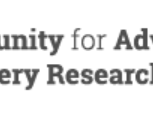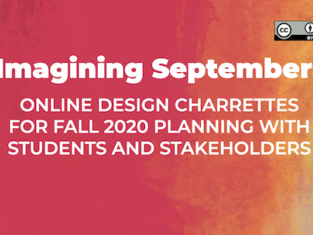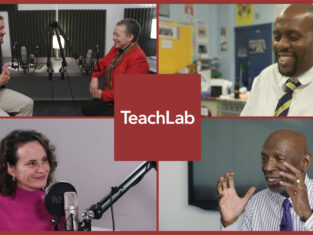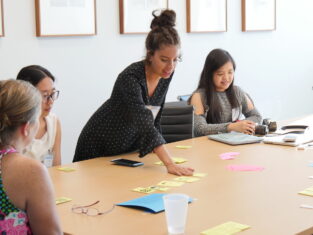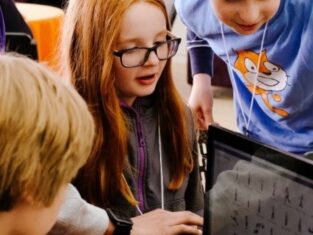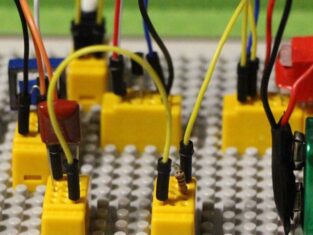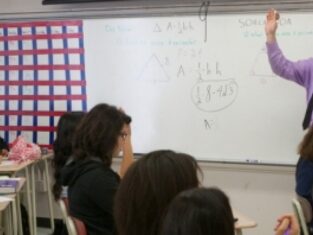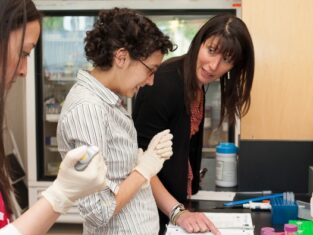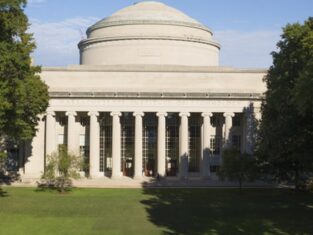
Future of Teacher Learning Provocation Series
In this series of provocations, we distill a series of arguments that we have heard from interviews with math researchers, teachers, teacher leaders, and publishers. We’ve chosen six of the most interesting lines of thinking to publish in advance of the Future of Math Teacher Learning conference to set the table with a set of ideas that we can debate, build upon, or discard. These provocations are not the “right” way to think about the future of math teacher learning, but they were six arguments that challenged our assumptions, sparked our thinking, and helped us imagine new ways of approaching teacher learning.
By Greg Benoit, Justin Reich, and the INSPIRE-Math team
While some of us are extremely glad 2020 has ended and are eager to look forward to the new year, we must not forget the humbling lessons about racial inequity, social justice (or lack thereof) and humanity the year taught us. The brutal killings of people of color, including George Floyd, Breonna Taylor, Rayshard Brooks, and Ahmaud Arbery, have taught us that we are not as far removed from the Jim Crow era as we once imagined. As the news covered the Black Lives Matter protests, we were forced to revisit (or uncover) our nation’s long history of racial violence, injustice, and economic inequality. And, not to mention, a global pandemic crippled the nation and further exacerbated the discrepancies and divides mentioned above.
As bleak and dreadful as those times were, they did not call for us, as a society, to turn on one another, nor did they call for us to return to “normal” knowing normal was rooted in the marginalization of communities of color. At a time when racist acts were becoming normalized, many mathematics educators saw that as an opportune time to rupture traditional ways of instructing and doing mathematics (e.g. direct instruction with an emphasis on procedure). As an effort to be more culturally responsive, teachers have decided to make use of intricate connections to community and cultural knowledge for mathematical instruction, affirming the cultural and national identities of their student body. Teachers have also begun to leverage systemic issues of inequality, violence, policing, etc. for mathematics instruction as a way to help students understand issues/context, formulate mathematical arguments and become critically aware of the world around them.While some consider mathematics a “universal language”, rooted in objectivity and emotionlessness (Christensen, Skovsmose, & Yasukawa, 2008), it is not. Mathematics teaching and learning does not operate from an apolitical stance; immune from issues of race, power and social class (Valero, 2018). And just like any other discipline, mathematics is laden with social, cultural and political practices and expectations (Gutiérrez, 2013).
In particular, one example of culturally responsive mathematics instruction is social justice mathematics. Rooted in Macedo and Freire’s notion of ‘critical education’ (1987), social justice mathematics challenges traditional mathematics and empowers students to question, critique, understand and confront important inequities in their lives inside or outside the school walls. Social justice mathematics requires mathematics educators and learners to reflect ‘through’, ‘with’, and ‘on’ mathematics (Skovsmose, 2011). Reflecting ‘through’ mathematics calls for teachers and students to engage in meaningful mathematics where students are empowered to satisfy their goals, asking and answering questions they have; reflecting ‘with’ mathematics enables teachers and students to see mathematics as a vehicle to understand issues or context, whether they be political, social, cultural, or economic; and reflecting ‘on’ mathematics considers its privileged position as a discipline used to make and justify decisions (Wright, 2016).
While we agree with the tenets of mathematics of social justice mathematics, it should not be done superficially (e.g. just adding diverse names to a word problem) nor should the concentration be solely on mathematical content. Though teachers may have good intentions examining the mathematics behind social injustices, it can be demoralizing for students if the lesson is facilitated negligently. For example, a lesson can elegantly demonstrate the racial and ethnic disparities of the school to prison pipeline or the prison industrial complex. And as the lesson wraps up a student optimistically asks, “now what?” While the content goal was reached and the lesson is over, the student is in search and in need of more.
It’s not enough to simply examine and uncover social justice issues of significant caliber but it is also important to discuss future action. Students should be solutions oriented and begin to recognize and explore how they can become change agents in the world. For example, students can have their option of using data to prepare a letter, public service announcements, or other forms of civic engagement to advocate for justice and equality. If time does not permit such extensions, consider cross-curricular options with other teachers, perhaps a humanities teacher. These are sophisticated topics and should be instructed with care.
Moreover, not all social justice mathematics lessons have to use high-profile events or be geared towards inequities. While there are countless fields, including the environmental and health care fields that consist of inequities, if teachers are not comfortable facilitating such a lesson, then there are less controversial topics that still explore equity questions. For example, teachers can have students explore and critique the mathematics ranking scheme used to judge their favorite musician, movie, actor, or examine the growth of historically black colleges and universities (HBCU) or other topics that focus on joy and positive framings of people of color.
We do not see culturally responsive mathematics teaching as one more thing to be added to the continuously evolving list of expectations for teachers but instead as an anchor to a new model of professional growth. As students see tangible examples of real-world applications that are significant to their lives, they begin to see mathematics as a tool that permeates the world and develop a further appreciation of its purpose. While a long history of resource deprivation in segregated schools and segregated tracks certainly needs to be addressed to create more equitable outcomes, the future for math instruction isn’t merely about resource allocation (much like addressing racial violence in policing isn’t solved by giving more money to urban police departments). The future of mathematics teacher learning calls for teachers to reimagine mathematical spaces as places that disrupt and transform learning to be liberating experiences for students, especially those that have been historically and currently marginalized. When mathematics teacher learning sees mathematics as a tool for liberation that acknowledges the lived experiences and the reality of its students, then it will truly begin its journey of creating equitable mathematics outcomes.
For decades, math reformers have tried a variety of strategies to create the conditions for equitable math outcomes in a deeply inequitable society. The heart of most of those strategies has been to assume that affluent White students get the “right” math instruction, and poor Black and Brown students get math instruction that isn’t enough like the classroom learning afforded to affluent, White students. While a long history of resource deprivation in segregated schools and segregated tracks certainly needs to be addressed, a more equitable future for math instruction isn’t merely about resource allocation (much like addressing racial violence in policing isn’t solved by giving more money to urban police departments). The future of math teacher learning should be anchored around seeing mathematics as essential to the liberation of historically and currently marginalized students, and then recognizing that when liberation is the north star, everything from curriculum, to instructional practice, to teacher recruitment, to assessment needs to be revisited through a liberatory lens.
Looking for more? Join leading voices in the field on January 28@2-5pm EST and February 2@5-8pm EST at The Future of Math Teacher Professional Learning.
References
Christensen, O. R., Skovsmose, O., and Yasukawa, K. (2008). The mathematical state of the world—Explorations into the characteristics of mathematical descriptions. ALEXANDRIA Revista de Edu- cação em Ciência e Tecnologia, 1, 77−90.
Freire, Paulo & Macedo, Donaldo (1987) Literacy: reading the word and the world. Amherst: Bergin & Garvey.
Gutiérrez, R. (2013). The sociopolitical turn in mathematics education. Journal for Research in Mathematics Education, 44(1), 37-68.
Skovsmose, O. (2011) An Invitation to Critical Mathematics Education. Rotterdam:SensePublishers
Valero P. (2018) Political Perspectives in Mathematics Education. In: Lerman S. (eds) Encyclopedia of Mathematics Education. Springer, Cham. https://doi-org.ezproxy.bu.edu/10.1007/978-3-319-77487-9_126-4
Wright, P. (2016). Social justice in the mathematics classroom. London Review of Education, 14(2), 104-118.






